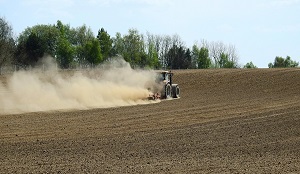![]() Production Challenges is a news and information topic monitored and covered by: Prepper Watch – Food Concerns
Production Challenges is a news and information topic monitored and covered by: Prepper Watch – Food Concerns
Introduction
In recent years, the world has seen an increasing frequency of natural disasters, climate events, and geopolitical instability, all of which contribute to significant production challenges.
Adverse weather conditions such as droughts, floods, and extreme temperatures have put pressure on global agricultural systems. Water shortages, resource depletion, and rising costs further exacerbate the problem, reducing crop yields and food production. For preppers, who aim to become self-sufficient and resilient in the face of these challenges, it’s vital to develop strategies to mitigate the risks associated with production limitations.
This Posting outlines how a prepper can prepare for production challenges by understanding key issues such as adverse weather patterns, water shortages, and resource constraints that impact food production. It also provides practical steps and solutions to help preppers thrive in uncertain times.
The Impact of Adverse Weather on Food Production
Adverse weather is a growing concern for food production worldwide. Unpredictable patterns such as droughts, floods, hailstorms, and extreme temperature fluctuations can have devastating effects on crops. A crop that thrives in certain environmental conditions may fail when those conditions become hostile.
- Droughts
Droughts have become more severe and frequent due to global climate change. They deprive crops of essential water, stunting growth and leading to low yields. For preppers, the primary concern is the impact of prolonged droughts on food and water sources.
Preparation:
- Drought-Resilient Crops: Preppers should prioritize planting drought-resistant crops such as sorghum, millet, and certain varieties of beans that can withstand dry conditions.
- Efficient Water Use: Implement rainwater harvesting systems, water conservation techniques (such as mulching and drip irrigation), and water storage tanks to ensure crops receive adequate moisture during dry spells.
- Greenhouses and Shade Structures: Protecting crops from extreme heat by using greenhouses, shade netting, or other protective structures helps maintain a stable growing environment even during hot periods.
- Flooding
While droughts reduce water availability, flooding can drown crops and erode valuable soil. Excessive rainfall or rapid snowmelt can lead to flooding that damages fields and washes away seeds or young plants.
Preparation:
- Raised Beds and Terracing: Raised garden beds or terracing can prevent water from overwhelming crops by allowing for better drainage and minimizing soil erosion.
- Flood-Resistant Varieties: Certain crops are more resilient to excess water, such as rice, which thrives in flooded conditions. Choosing the right crop for your location and climate is key.
- Proper Drainage: Installing proper drainage systems in gardens and farm fields can help prevent water accumulation, reducing the risk of crop loss during floods.
- Temperature Extremes
Extreme temperatures, whether freezing cold or excessive heat, can also harm crops. Frost can damage young plants, while heatwaves can cause plants to wilt and fail.
Preparation:
- Seasonal Planning: Preppers should plan their planting schedules based on local climate conditions, choosing crops that are suited to specific temperature ranges. Cold-weather crops like kale, spinach, and cabbage should be grown in cooler months, while heat-loving crops such as tomatoes and peppers are best planted after the last frost.
- Frost Protection: Using row covers, cloches, or other frost protection methods can help insulate plants during unexpected cold spells, ensuring they survive the frost.
- Heat-Tolerant Varieties: Selecting heat-tolerant varieties of crops ensures higher survival rates during heatwaves. These varieties are bred to tolerate higher temperatures and still produce food.
Water Shortages and Their Impact on Food Production
Water is arguably the most critical resource for growing food, yet it is also one of the most threatened by changing climate conditions and population growth. Water scarcity affects both urban and rural areas, as rivers, lakes, and groundwater sources are increasingly strained.
- Water Efficiency Measures
In areas where water is scarce, preppers can take several steps to optimize water usage in their food production systems.
Preparation:
- Rainwater Harvesting: Setting up rainwater collection systems allows preppers to capture and store rainwater, reducing reliance on municipal or well water. These systems can be as simple as rain barrels or as advanced as large-scale catchment systems with filtration and storage tanks.
- Drip Irrigation Systems: Drip irrigation delivers water directly to the roots of plants, minimizing waste and ensuring water is used efficiently. This method is ideal for drought-prone areas, as it ensures that water is not lost through evaporation or runoff.
- Greywater Recycling: Using greywater (wastewater from sinks, showers, or washing machines) for irrigation can significantly reduce water usage. However, it’s important to use non-toxic, biodegradable detergents and soaps to ensure that the water does not harm plants.
- Soil Moisture Management
Soil moisture retention is key to maintaining healthy crops, especially during periods of low rainfall. Improving soil structure and implementing moisture-preserving techniques can go a long way in combating water scarcity.
Preparation:
- Mulching: Applying a layer of organic mulch around plants helps retain soil moisture, reduces evaporation, and suppresses weed growth.
- Composting: Adding compost to the soil increases its water-holding capacity and helps create a nutrient-rich environment for plants.
- Soil Amendments: Using soil amendments such as biochar can improve the soil’s water retention, allowing crops to survive longer periods without irrigation.
Resource Limitations and Their Effect on Food Production
Beyond weather and water, other resource limitations can also constrain food production. These limitations include access to seeds, fertilizers, and labor. As the global population continues to grow, demand for these resources increases, often leading to shortages or price hikes.
- Seed Saving and Self-Sufficiency
For preppers, relying on external sources for seeds can be risky, especially when supply chains are disrupted. Growing your own seed stock ensures that you have a continual supply of seeds for future crops.
Preparation:
- Heirloom Seeds: Heirloom varieties of seeds are open-pollinated and can be saved and replanted year after year without loss of quality. Unlike hybrid seeds, they are better suited to long-term self-sufficiency.
- Seed Storage: Preppers should invest in proper seed storage techniques, including using cool, dry, and dark storage spaces. Seed vaults or airtight containers can help preserve seeds for several years.
- Crop Rotation: Practicing crop rotation not only helps prevent soil depletion but also maintains healthy soil for future harvests. Different plants have different nutrient requirements, and rotating crops helps ensure that the soil remains balanced.
- Fertilizers and Soil Health
Fertilizers are essential for maintaining healthy soil and promoting crop growth, but chemical fertilizers can be expensive and may not be readily available during times of crisis. Additionally, excessive use of synthetic fertilizers can degrade soil health over time.
Preparation:
- Composting and Organic Fertilizers: Composting kitchen scraps, yard waste, and animal manure can provide valuable nutrients for the soil. Organic fertilizers like fish emulsion, bone meal, and blood meal can be used to replenish the soil’s nutrients without relying on synthetic products.
- Soil Testing: Regular soil testing helps preppers understand the specific nutrient needs of their soil, allowing them to make informed decisions about fertilization and amendments.
- Agroecology: Implementing agroecological practices, such as using cover crops to add nitrogen to the soil or incorporating natural pest control methods, can reduce dependence on external resources and improve soil health.
- Labor and Skills Development
Growing food during times of scarcity or instability often requires significant manual labor. Developing the necessary skills to grow, harvest, and preserve food is crucial for preppers who want to ensure long-term self-sufficiency.
Preparation:
- Training and Education: Preppers should educate themselves on a variety of food production techniques, including gardening, farming, and livestock management. Participating in local gardening or farming groups can provide valuable hands-on experience and knowledge.
- Efficient Tools: Investing in efficient tools, such as hand-powered equipment for planting and harvesting, can reduce the physical labor required to produce food. Additionally, preppers should maintain a good stock of these tools to avoid shortages during emergencies.
- Community Collaboration: Working with like-minded individuals in community-based prepper groups can help share the labor burden, especially during planting or harvest seasons. Mutual aid networks can also provide a support system during times of difficulty.
Conclusion: Resilience and Self-Sufficiency in the Face of Production Challenges
Production challenges such as adverse weather, water shortages, and resource limitations are becoming more prevalent, and they will continue to affect food security worldwide. However, by taking proactive measures to prepare for these challenges, preppers can ensure they remain self-sufficient and resilient in the face of adversity.
Key strategies include planning for droughts and floods, optimizing water usage, saving seeds, improving soil health, and developing the necessary skills to grow and preserve food. By understanding the potential risks and developing a comprehensive plan, preppers can reduce their reliance on external sources and improve their ability to thrive during times of uncertainty.

